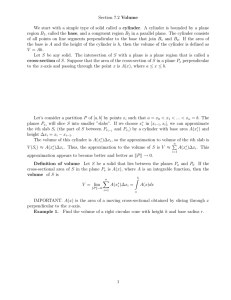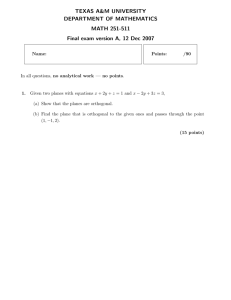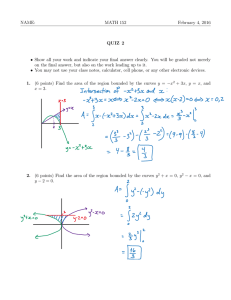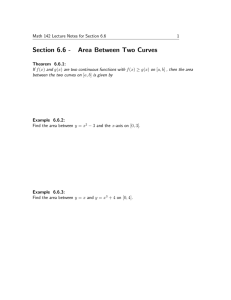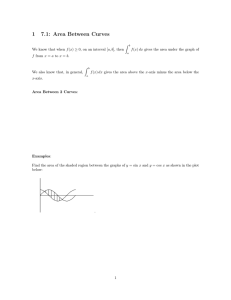Math 152, Fall 2008 Lecture 3. 09/02/2008
advertisement
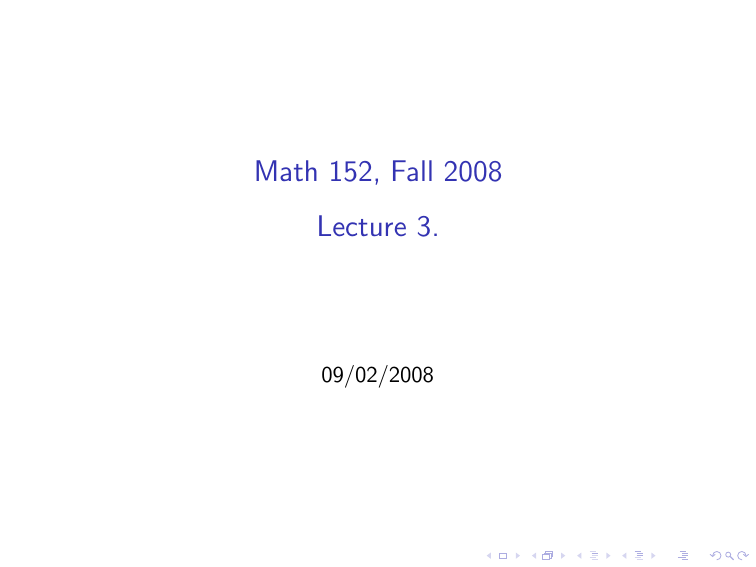
Math 152, Fall 2008
Lecture 3.
09/02/2008
Chapter 7. Applications of integration
Section 7.1 Areas between curves
The area of the region S that lies between two curves y = f (x)
and y = g (x) and between the vertical lines x = a and x = b, is
Rb
A = |f (x) − g (x)|dx
a
y
y = f (x)
S
0
a
b
x
y = g(x)
Fig.1
S = {(x, y ) : a ≤ x ≤ b, g (x) ≤ y ≤ f (x)}
If a region is bounded by curves with equations x = f (y ),
x = g (y ), y = c and y = d, where f and g are continuous
functions and f (y ) ≥ g (y ) for all y in [c, d], then its area is
Rd
A = [f (y ) − g (y )]dy
c
y
d
S
x = f (y)
x = g(y)
c
0
Fig.2
x
S = {(x, y ) : g (y ) ≤ x ≤ f (y ), c ≤ y ≤ d}
Example 1. Find the area of the region bounded by
x2
1
and
y
=
(a) y =
1 + x2
2
(b) x = y 3 − y and x = 1 − y 4 (see Fig.3)
y
x = y3 − y
x = 1 − y4
x
0
Fig.3
Section 7.2 Volume
We start with a simple type of solid called a cylinder. A cylinder is
bounded by a plane region B1 , called the base, and a congruent
region B2 in a parallel plane. The cylinder consists of all points on
line segments perpendicular to the base that join B1 and B2 . If the
area of the base is A and the height of the cylinder is h, then the
volume of the cylinder is defined as V = Ah.
Let S be any solid. The intersection of S with a plane is a plane
region that is called a cross-section of S. Suppose that the area
of the cross-section of S in a plane Px perpendicular to the x-axis
and passing through the point x is A(x), where a ≤ x ≤ b.
Let’s consider a partition P of [a, b] by points xi such that
a = x0 < x1 < ... < xn = b. The planes Pxi will slice S into smaller
”slabs”. If we choose xi∗ in [xi −1 , xi ], we can approximate the i th
slab Si (the part of S between Pxi −1 and Pxi ) by a cylinder with
base area A(xi∗ ) and height ∆xi = xi − xi −1 .
The volume of this cylinder is A(xi∗ )∆xi , so the approximation to
volume of the i th slab is V (Si ) ≈ A(xi∗ )∆xi . Thus, the
n
P
approximation to the volume of S is V ≈
A(xi∗ )∆xi . This
i =1
approximation appears to become better and better as kPk → 0.
Definition of volume Let S be a solid that lies between the
planes Pa and Pb . If the cross-sectional area of S in the plane Px
is A(x), where A is an integrable function, then the volume of S
n
Rb
P
is V = lim
A(xi∗ )∆xi = A(x)dx
kPk→0 i =1
a
IMPORTANT. A(x) is the area of a moving cross-sectional
obtained by slicing through x perpendicular to the x-axis.
Example 2. Find the volume of a right circular cone with height
h and base radius r .
Let S be the solid obtained by revolving the plane region R
bounded by y = f (x), y = 0, x = a, and x = b about the x-axis.
A cross-section through x perpendicular to the x-axis is a circular
disc with radius |y | = |f (x)|, the cross-sectional area is
A(x) = πy 2 = π[f (x)]2 , thus, we have the following formula for a
Rb
volume of revolution: V = π [f (x)]2 dx
a
The region bounded by the curves x = g (y ), x = 0, y = c, and
y = d is rotated about the y -axis, then the corresponding volume
Rd
of revolution is V = π [g (y )]2 dy
c
Let S be the solid generated when the region bounded by the
curves y = f (x), y = g (x), x = a, and x = b (where f (x) ≥ g (x)
for all x in [a, b] ) is rotated about the x-axis. Then the volume of
Rb
S is V = π {[f (x)]2 − [g (x)]2 }dx
a
Example 3.
(a) Find the volume of the solid obtained by rotating the region
bounded by y = x 2 + 1, y = 3 − x 2 about the x-axis.
(b) Find the volume of the solid obtained by rotating the region
bounded by y = 2x − x 2 , y = 0, x = 0, x = 1 about the y -axis.
(c) Find the volume of the solid obtained by rotating the region
bounded by y = x 4 , y = 1 about y = 2.
Example 4. Find the volume of a frustum of a pyramid with
square base of side b, square top of side a, and height h.
